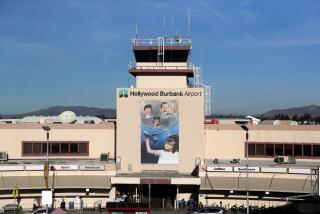FAA Takes Steps to Reduce Risk of Runway Collisions
- Share via
WASHINGTON — The Federal Aviation Administration, attempting to reduce near collisions on the nation’s runways, announced Monday that Burbank, John Wayne and 23 other medium-size airports have been chosen for installation of a new ground radar system.
The announcement by FAA Administrator Jane Garvey came at the opening of a three-day national meeting on improving runway safety. With close encounters involving planes on runways now averaging one a day, Garvey declared, “taxiing on the airport surface is the most hazardous phase of flight.”
Garvey also said that the FAA would adopt some of the recent runway safety recommendations by the National Transportation Safety Board. For example, to avoid misunderstandings, U.S. controllers will be required to use standard international terminology when communicating with pilots.
After years of watching the number of near collisions creep steadily higher, Garvey said, “the FAA is committed--as we have never before been committed--to improving runway safety. We want to move beyond the record into results.”
Ground radar is now used at major airports such as Los Angeles International to help controllers scan runways and taxiways. But busy medium-size airfields like Orange County’s John Wayne must rely on controllers peering through binoculars and talking with pilots by radio.
That age-old system can break down, especially in bad weather or at night. The new ground radar, which is still under development, is not expected to be in operation until the fall of 2002.
Two other Southern California airports--Burbank and Ontario--will receive the new ground radar, the FAA said.
John Wayne--with its mix of big jets, corporate aircraft and small propeller planes--had nine close calls on its runways last year, second highest in the nation.
“We’ll take any technology we can get,” Bill Withycombe, Western regional administrator for the FAA, said recently. The new system would “give more information to the controllers, is what it boils down to.”
Michael Hart, deputy airport director for operations at John Wayne, welcomed the FAA’s announcement Monday. But he stressed that the agency must also continue its efforts to educate and admonish pilots about the seriousness of the situation.
“The everyday analogy is people running red lights,” Hart said. “Until people get stopped, they’re going to continue to do it.”
Long Beach airport will not get the new system, although it had more near-collisions last year than Burbank and Ontario. It is not clear why Long Beach was left off the list. A spokesman for the airport was not available. With six incidents last year, Long Beach was 10th in the nation. This year, it already has recorded seven.
Only last Friday, a taxiing Cessna failed to stop as instructed near a runway on which another private plane was taking off at the Long Beach facility. The two planes were as close as 500 to 1,000 feet, an FAA official said.
Other California airports that will get radar systems include Oakland, Sacramento and San Jose.
Garvey said the 25 airports that will receive the ground radar were selected after an analysis of accident risks, with advice from experts at the Massachusetts Institute of Technology. “We will add more airports to the list if the analysis justifies this,” Garvey said.
Ground radar for medium-size airports is one of several technological initiatives underway to improve runway safety.
The FAA wants a system that will be more flexible and less expensive than ground radars now in use at major airports. Plans call for it to be assembled from commercially available components and to be able to work with other technologies, such as satellite navigation devices, locater beacons on aircraft or even in-pavement sensors on runways.
“The key element here will be fusion capability--fusion being the ability to join together different types of information,” John Mayrhofer, head of the FAA’s runway safety program, said recently. Congress has earmarked $7.6 million to purchase the new radar systems.
The FAA will issue a formal request for bids sometime in September, officials said. The FAA’s September 2002 operational deadline is “very optimistic,” according to the Transportation Department inspector general’s office.
FAA officials said a prototype of the new ground radar has been tested at Dallas/Fort Worth International Airport with promising results.
Garvey pledged an unprecedented effort. “Improving runway safety has my full attention,” she said. “This program has a central focus, accountability and real deadlines.”
More to Read
Inside the business of entertainment
The Wide Shot brings you news, analysis and insights on everything from streaming wars to production — and what it all means for the future.
You may occasionally receive promotional content from the Los Angeles Times.










